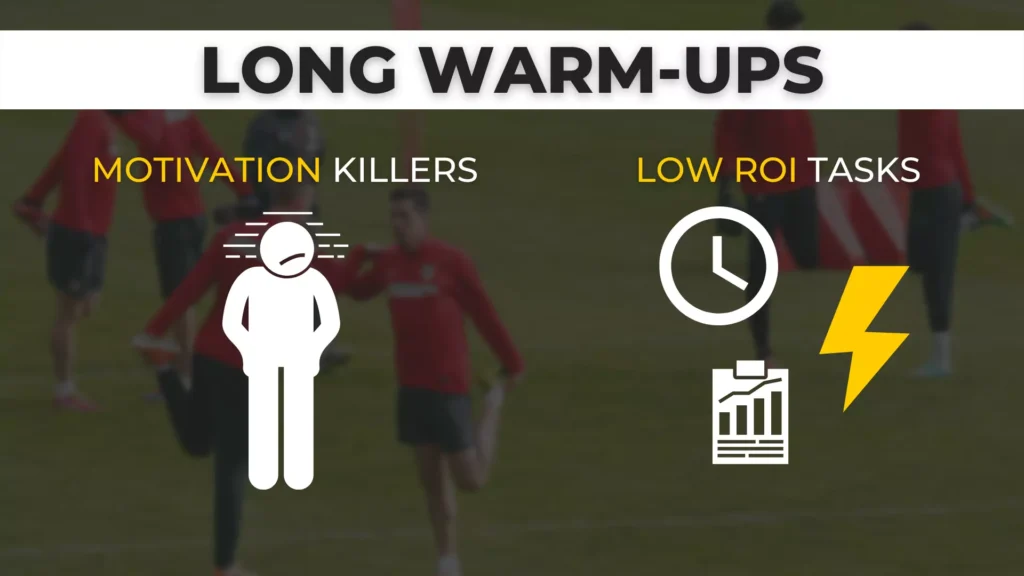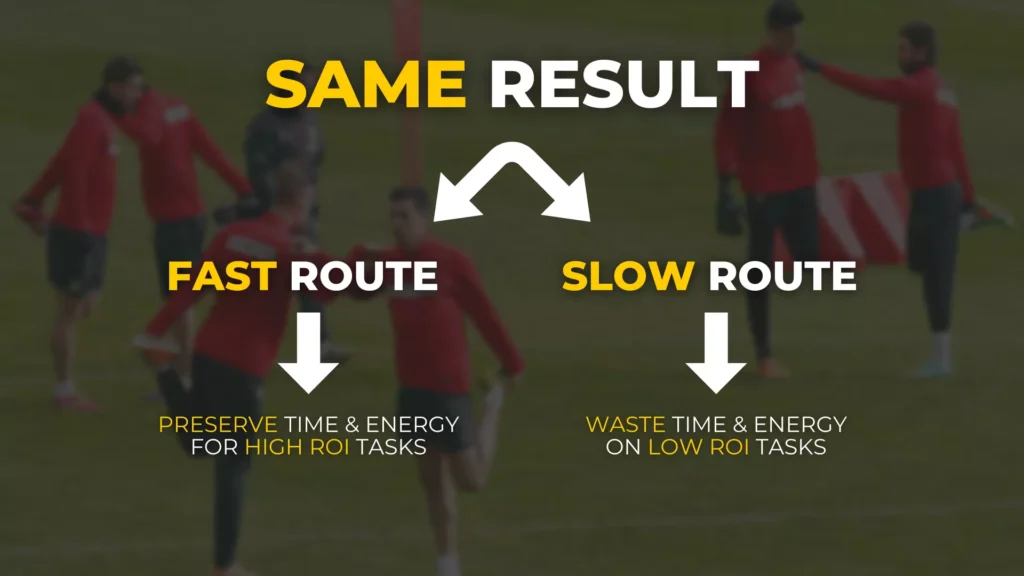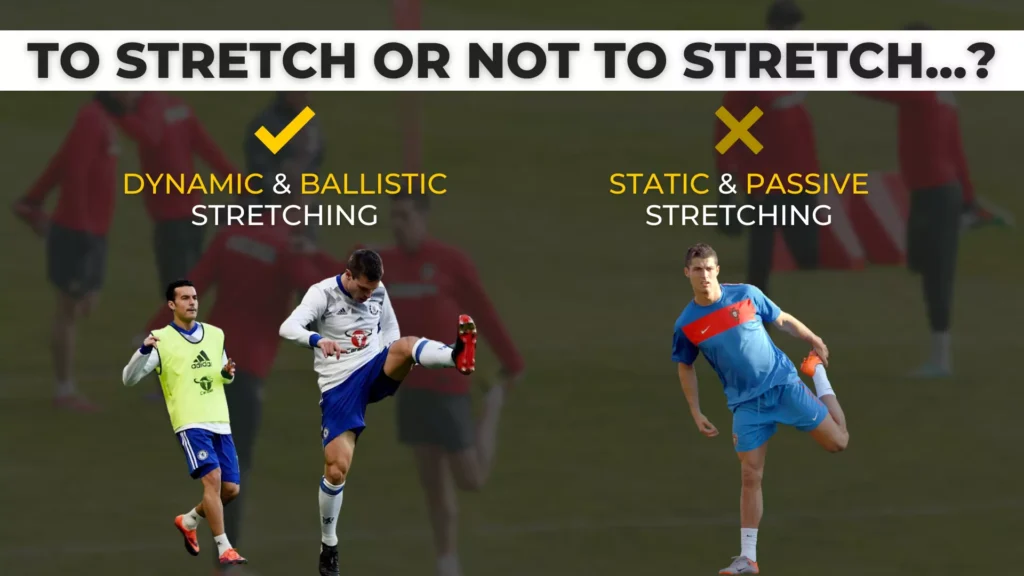
Are you tired of this long, boring warm-up your old-school football coach swears by?
Well, I hope so, because we’re about to bust some myths and warm-up staples that have been around for decades in the world of football and that you’re most probably doing as well.
You see, these mistakes and myths that we are about to bust, aren’t only proven to be a bad investment of your time and energy but they can also be dangerous by drastically increasing your risk of injury.
BORED OF READING AN ENTIRE ARTICLE? HERE’S AN IN-DEPTH VIDEO!
Long, Boring, Energy-Consuming Warm-Ups
So the first mistake has to do with the total volume of your warm-up.
Nowadays, it is quite easy to get caught up with all those fancy activation exercises and warm-up methods that can quickly turn your warm-up into an actual workout.
Warm-ups that exceed the 20-minute mark are usually a waste of your two most valuable resources; your time and energy.
Your goal when warming up is to prepare your neuromuscular system for intense action and transition into the main activity as smoothly as possible. This is something that you can and should achieve in less than 15 to 20 minutes.
RELATED: How To Warm-Up Properly For A Football Match/Training Session
But why is this true?
So, the reason long warm-ups aren’t energy- and time-efficient is simple.
Number one; they literally are motivation killers. Long warm-ups can drastically decrease your desire to perform at your peak later on and number two; long warm-ups are usually quite high in low ROI tasks that drain your energy and time resources.
That time and energy you waste could be spent on training tasks with a higher return on investment. This can be anything from technical work to prehab. You can find more ideas by watching our warm-up video or article.

I want you to do one thing; every time you’re warming up ask yourself; is this warm-up taking up too much of the session? Could I be spending that extra time and energy on some activity with a higher return on investment?
Be real with yourself and understand that quantity doesn’t equal quality. If you can achieve the same results through a faster route, why take the slower path and waste valuable time and energy?

Be careful though! I am NOT telling you to sacrifice the quality of your warm-up, I’m just asking you to be more mindful about your time and energy every time you’re warming up.

*As an affiliate, I'm earning from qualifying purchases without any extra charges being placed on you.
To Stretch Or Not To Stretch…?
Now, another great mistake you’re probably doing has to do with stretching.
Stretching is one of the warm-up staples many football coaches swear by.
But let me be more specific.
Not all types of stretching are considered a “bad” warm-up alternative in football. If you have watched our warm-up video (CTA) you already know that dynamic and ballistic stretching are two things you definitely want. However, static and passive stretching is something you should generally avoid in your warm-ups.

And I know, this might go against your old-school coach that always includes static stretches in the warm-up but according to science, that’s the truth!
Now, someone may argue that there’s hardly any difference at all but if you’re watching this video, I’m quite sure you’re amongst those players that always seek growth, no matter how marginal the gain is going to be.
So to conclude my opinion, yes, static stretching is something that can limit your performance if you use it as a warm-up method.
That’s what sports science and studies are suggesting as well.
But why is this true, you may ask?
One of the leading scientific theories on this topic has to do with the length-tension relationship of your skeletal muscle.
Now, I don’t want to drown you with scientific info so I’m gonna try and make this as simple as possible.

*As an affiliate, I'm earning from qualifying purchases without any extra charges being placed on you.
Your muscles are capable of expressing the most amount of force they can produce when they’re stretched up within a moderate range of motion which is known as your muscle’s ideal length.
If you include long static stretches in your warm-ups, you’re over exceeding this ideal length in which your muscles are optimally transferring energy and you’re basically limiting your force outputs.
As a result, the length-tension relationship of your muscles gets inhibited and you simply aren’t efficient at transferring energy and subsequently, producing force.
RELATED: Is Static Stretching Bad For Football Performance?

Warm-Ups & High Temperatures
The next mistake you’re doing has to do with the temperature and climate you’re warming up in and how it affects your physiology.
As you may already know from our warm-up video, one of the objectives of a warm-up is to increase the rate of various physiological functions of your body, such as your muscle temperature, your heart rate, and your blood flow.
However, if you’re training in hot and humid conditions you might wanna reconsider the first phase of the RAMP protocol and maybe decrease or limit it.
The reason behind that is that hot and humid climates can really speed up the increases we wanna see in your physiological functions. This means that the first 5 minutes you would usually spend running or performing light intensity actions on the ball aren’t necessary and can even add up on your energy systems depletion.
If the climate is hot, adopt a smarter and more energy-efficient approach for your warm-up, and don’t forget to include adequate water breaks!
Neglecting Re-Warm-Ups
Next up we have the half-time period. It is REALLY common to see players neglecting a re-warm-up before the second half and that might be one of the reasons your performance feels and looks sluggish for the first 10 to 15 minutes of the second half.
Unfortunately, this is an area that is often getting overlooked by both the coaching staff and the players themselves.
Studies suggest that by just following some basic steps and re-warm-up methods you can sustain a great level of performance and gain an edge over your opponent, so why not take full advantage of that time?!
The things you should do are pretty simple and straightforward.
First of all, make sure that the room temperature in the locker room is quite high or get equipped with warm clothing. This will help you sustain a high muscle temperature which is one of the most important factors to consider during half-time.
Now, 3 to 5 minutes before the next half starts, perform some basic dynamic and ballistic stretches as well as some high-intensity actions like cuts and sprints. Keep the duration and repetitions quite low though since we don’t wanna drain you.
Keep it short and sharp.
Do This Next…
So now that we went over these 4 mistakes, I want you to take action and do something really important! Either check out our warm-up video or article to gain clarity on how you SHOULD structure your warm-ups as a footballer.
Also, let me know which of these mistakes you’ve been guilty of in the past by DMing us on Instagram (@footxfit)? And of course, if you have ANY questions, make sure to ask them as well!
RELATED ARTICLES
- How To Warm-Up Properly For A Football Match/Training Session
- Is Static Stretching Bad For Football Performance?
- Jogging & Steady State Runs For Football Conditioning?
- The Half-Time: A Strategic Approach For Footballers
REFERENCES
[1] Simic L, Sarabon N, Markovic G. Does pre-exercise static stretching inhibit maximal muscular performance? A meta-analytical review. Scand J Med Sci Sports. 2013 Mar;23(2):131-48. doi: 10.1111/j.1600-0838.2012.01444.x. Epub 2012 Feb 8. PMID: 22316148.
[2] Amiri-Khorasani, Mohammadtaghi et al. “Acute Effect of Different Combined Stretching Methods on Acceleration and Speed in Soccer Players.” Journal of human kinetics vol. 50 179-186. 13 Apr. 2016, doi:10.1515/hukin-2015-0154
[3] Sayers, Adam L; Farley, Richard S; Fuller, Dana K; Jubenville, Colby B; Caputo, Jennifer L The Effect of Static Stretching on Phases of Sprint Performance in Elite Soccer Players, Journal of Strength and Conditioning Research: September 2008 – Volume 22 – Issue 5 – p 1416-1421
doi: 10.1519/JSC.0b013e318181a450
[4] Edholm P, Krustrup P, Randers MB. Half-time re-warm up increases performance capacity in male elite soccer players. Scand J Med Sci Sports. 2014 Apr 30. doi: 10.1111/sms.12236. Epub ahead of print. PMID: 25048430.
[5] Hammami A, Zois J, Slimani M, Russel M, Bouhlel E. The efficacy and characteristics of warm-up and re-warm-up practices in soccer players: a systematic review. J Sports Med Phys Fitness. 2018 Jan-Feb;58(1-2):135-149. doi: 10.23736/S0022-4707.16.06806-7. Epub 2016 Nov 30. PMID: 27901341.




